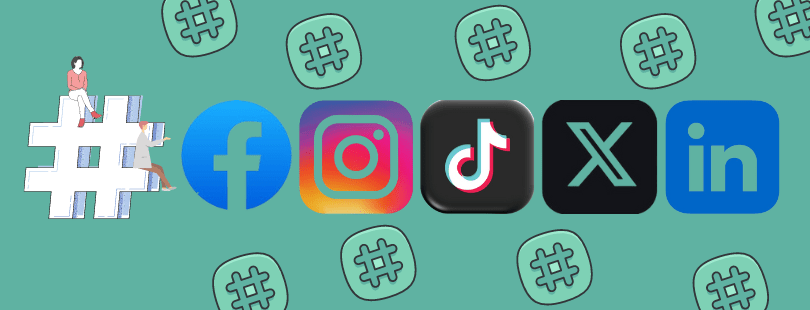Since American blogger Chris Messina proposed using the "#" symbol in 2007 on Twitter to categorize related messages, hashtags have revolutionized digital communication. Just six years later, hashtags became integral to viral campaigns thanks to the #CeaseFire hashtag from a social media campaign advocating for global peace.
The pound sign quickly became an effective way to spread news, call attention to different movements, and celebrate events. In recent years, social media marketing hashtags have also been instrumental in organizing content and stylistic choices based on aesthetics.
That speaks volumes about the impact of this symbol in the digital world. Hashtags help your content be more visible and reach and engage its audience, but they require careful selection and strategic use.
Our guide will help you understand how to use hashtags in social media marketing effectively, ensuring your campaigns’ success.
Understand the Role of Hashtags in Social Media Algorithms
Many users remember the internet of the 2000s as a digital wild west, with much less sophisticated algorithms and limited control over what appeared in their social media feeds.
Initially, hashtags were merely tools for categorization, lacking significant influence on content visibility; however, they evolved alongside social media algorithms.
Modern algorithms prioritize content based on engagement, relevance, and user behavior, making hashtags essential for content discovery and distribution. This simplifies the search function on social media search. Thanks to that, users can easily find trends, posts, conversations, and events related to a specific hashtag.
Clicking on a hashtag reveals a feed of all public posts using that keyword on the respective social media platform. For example, when a user types #photooftheday on Instagram or Twitter, the feed will showcase a curated selection of images that users have deemed their best photo of the day. That’s why marketers use hashtags for social media marketing to target specific audiences and boost engagement. However, some may overlook search volume or choose hashtags people rarely search for.
How to Choose the Best Hashtags for Social Media Marketing
Hashtags will help your content find its way to the right audience, but only if you select them strategically. The following tips will help you identify the most effective ones.
1. Be Precise
Strike the right balance between precision and relevance. Consider your target audience and which hashtags they’re most likely to use when researching a product.
You don’t want to add unnecessary details, but you do want to stay on point. For example, if you’re a web designer, you may mention a specific service you offer (e.g., #responsivewebdesign) instead of solely using the #webdesign hashtag.
On the flip side, if you work with fashionwear, consider yourself lucky. Fashion-related hashtags, such as #StreetStyle, allow you to reach nearly 35 percent of American Instagram users.
2. Keep it Short
Although long hashtags can perform well if relevant, aim for those that are simple and easy to remember. Users can spell and pronounce short hashtags without issue, making them more likely to become part of trending conversations. Moreover, the meaning of short social media marketing hashtags is easier to grasp and doesn’t require much thought. However, this isn’t to say you should use generic or never-used-before hashtags, as they are unlikely to reach anyone.
The safest way to choose short and meaningful hashtags is to find ones that social media users already discuss and are relevant to your company and content.
3. Check Hashtag Recency and Volume
Never include irrelevant or outdated hashtags that are no longer in use when tagging content. For example, using #NewYears2024 on January 1, 2025, would be ineffective. Therefore, you must ensure your hashtags are current, relevant, and popular.
Another aspect to consider is the volume of hashtags, which refers to their frequency of use on social media within a specific timeframe. High-volume hashtags typically reach a larger audience and have greater engagement potential but face more competition.
Meanwhile, low-volume hashtags may target a more niche audience, which can be advantageous if you’re aiming for a specific community or industry. Social media analytics tools or hashtag tracking platforms can provide data on hashtag usage frequency, streamlining your hashtag selection process.
4. Check Your Competition
Research what hashtags your competition uses and determine which ones work well for them. You can use the ones that align with your products or services, as those have already proven effective in reaching your target audience.
5. Use Branded Hashtags
Seven out of ten hashtags are branded, meaning businesses create custom hashtags for promotion. Customization is the best option for ensuring your campaign is visible and precise because the hashtag will include your brand’s name.
You can create hashtags containing the name of your company’s products, campaigns, or slogans. These hashtags also encourage user-generated content. For example, customers can include your branded hashtags when posting photos of the products they purchased, boosting your social media presence.
6. Become a Part of Trending Topics and Conversations
Popular hashtags are among the rare bandwagons worth hopping on. Trending topics already include hashtags that people often use, so joining them lets you tap into an existing large audience.
However, these should be related to your products, services, brand, or content. You can discover them by keeping up with news and trends in your niche and then checking associated hashtags.
If your industry is rarely a source of trends or you can’t find a common link, consider customizing your content to align it with popular topics. Another option is to join relevant conversations that are gaining traction among users. Monitor hashtags, industry news, and user-generated content that resonate with your audience and join discussions with meaningful and authentic contributions.
7. Create Giveaways and Contests
Users love the opportunity to win an item, service, or discount, meaning giveaways will boost engagement. You can establish momentum by creating multiple smaller contests and encouraging people to share content with relevant hashtags.
For example, an organic food eCommerce brand can promote healthy eating habits and showcase its products by asking participants to share photos or videos of their favorite healthy meals or snacks using the giveaway hashtags (e.g., #EatWellLiveWell).
8. Call Attention to a Relevant Topic
You can choose social media marketing hashtags related to a topic your target audience cares about. For instance, you may want to raise awareness about the importance of eco-friendly fashion, highlighting your company’s sustainable production practices. In that case, you can combine your brand’s name with an appropriate hashtag, such as #FashionWithPurpose.
How to Research Trending Hashtags on Social Media
When choosing the best hashtags for social media marketing, thorough research is vital.

Explore Social Media Platforms
Each social media platform allows exploring trending hashtags and topics through its search bar. Here’s how to perform research on different social media platforms:
- Facebook: Enter a relevant keyword into Facebook’s search bar to discover the most popular hashtags associated with it in the drop-down menu.
- Instagram: Use the platform’s search bar to explore relevant hashtags and refine your search by selecting the “Tags” option. You can also explore the “Explore” page for popular posts and additional hashtags.
- TikTok: Go to the platform’s search function, enter keywords relevant to your content or industry, and explore the suggested hashtags provided in the search results. Or you can browse popular videos to identify trending hashtags creators use.
- X (former Twitter): Use the platform’s search bar to explore relevant topics and trending hashtags, then click on the hashtag to view related tweets and gauge their popularity and relevance within your target audience.
- LinkedIn: The search bar allows you to browse relevant topics and hashtags and analyze the engagement metrics of posts using specific hashtags. However, you can also click the “My Network” icon and select the “Hashtags” tab. This section shows trending hashtags among your connections and provides insights into the conversations happening within your network.
Use Hashtag Research Tools
Various online tools suggest a list of relevant hashtags based on the keywords you’re interested in. These also provide analytics on reach, volume, engagement, and popularity.
Keep in mind that most research tools are premium, although you may find free versions with limited use. The following apps will get your hashtag search started:
- Hashtagify: This tool provides insights into hashtag performance, trends, and related hashtags.
- Keyhole: With this app, you get real-time tracking of hashtag performance, including reach, impressions, and engagement metrics.
- Trendsmap: Use it to visualize trending hashtags on a geographical map, allowing you to monitor local and global conversations in real time.
- RiteTag: This app suggests optimized hashtags based on real-time data.
- Tagboard: The unique feature of this platform is that it aggregates content across multiple social media platforms using specific hashtags and provides insights into conversations and trends related to a particular topic.
- Brand24: Thanks to this app, you can monitor social media mentions and track hashtag usage, enabling you to assess the effectiveness of your hashtag campaigns and find influencers within your niche.
Leverage Social Media Listening Platforms
Keep up with trending social media conversations to discover popular and relevant hashtags. You can monitor these discussions with social media listening tools, such as:
- Hootsuite: This app includes keyword monitoring and hashtag tracking, making it possible to analyze conversations and trends across multiple platforms.
- SproutSocial: With this tool, you can monitor brand mentions, track hashtags, and analyze audience engagement.
- Brandwatch: Sentiment analysis and trend detection are the integral features of this tool.
- Mention: This platform enables monitoring brand mentions, tracking hashtags, and analyzing social media conversations in real time.
- BuzzSumo: Thanks to this app, you’ll get insights into trending topics and popular content on social media.
However, every social media platform works differently, which could impact your social media marketing strategy.
How to Use Hashtags in Social Media Marketing to Magnify Your Impact Across Different Platforms
Regardless of the platform, never overuse hashtags, especially on Instagram, as you risk shadowban. Even though they didn’t confirm it, Instagram may limit your profile’s engagement and reach if you repeatedly use the same hashtags.
The safest practice is to avoid using one hashtag multiple times in 24 hours and no more than six occurrences within your most recent ten posts. You can ensure that doesn’t happen by always thinking through your hashtags and using them purposefully.
The following tips will help you tweak your strategy based on the platform.
You can add 30 hashtags in a post, and using the maximum can boost your engagement by 20 percent. However, never include unnecessary tags, and aim for at least 11 meaningful tags.
This platform is not known for hashtags and using them won’t impact your reach significantly. In fact, posts without hashtags typically perform better.
TikTok
Hashtags help categorize video content on TikTok, but they change often, requiring you to check the “Discover” page daily. But since a TikTok post can have up to 4,000 characters, you can include multiple hashtags and monitor which ones perform best.
X (Twitter)
Using one hashtag can trigger 69.7 more retweets on average for X users with under 1,000 followers. But since X allows 280 characters per post, aim for around three hashtags.
Users who add one or more hashtags increase their post visibility by nearly 30 percent. But always research whether the hashtag you have in mind exists, and don’t add more than five tags.
Be Thoughtful, But Don’t Overcomplicate
The golden rule is to match hashtags to your brand, industry, and trending conversations. Avoid mindlessly adding every popular tag and focus on those that will engage your audience while working well on a specific platform. However, hashtags are not always the best option for experimentation and creativity; instead, prioritize simplicity and precision. Consider teaming up with professionals who provide social media marketing services to help you polish your hashtag strategy.
If you want to learn more about how to use social media effectively, check the following resources:





